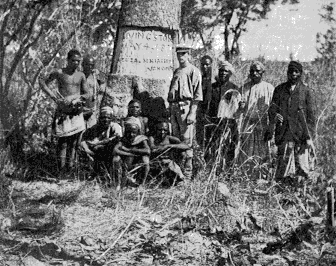Royal Geographical Society
Today, an old society stretches our minds. The University of Houston's College of Engineering presents this series about the machines that make our civilization run, and the people whose ingenuity created them.
The roots of the Royal Geographical Society, the RGS, are two centuries old. By the time it gained its Royal charter in 1859 it was already a social and scientific force. It still is today. It's a lot like our National Geographic Society. Both fund exploration. Our National Geographic magazine gives us huge visibility. But the Royal Society houses more information, and it's done more to change our globes.
The RGS is woven through David Livingstone's long African odyssey. Livingstone muddled things by chasing three objectives. He was a missionary, an explorer, and a passionate enemy of the Arab slave trade. When he died of disease after 32 years in Africa, the slave trade outlived him. The Missionary Society disowned him. He didn't locate the origin of the Nile. But he did set an example of dedication that carried on his causes long after he died. He awakened an electric interest in exploration.
His people took his body back to England, but first they took out his heart and buried it under the Mpundu tree in Africa. Meanwhile the Society had sent Speke and Burton to look for the origin of the Nile. They loathed each other, and they saw quite different things when they looked at Africa. Burton was tuned to Africa's culture and people. But in the end, Speke found where the Nile began.
In this century, the Society looked to Antarctica. They helped support Scott's attempt to reach the Pole. Scott made it, only to find that Amundsen had got there first. Then Scott's party died of starvation and exposure on the way back. The last ones died only 11 miles from base camp. A Society official drew fire when he said Amundsen had been luckier than Scott. In fact, Amundsen had been far better at surviving in 70-below weather
So the RGS went on to other things. It funded assaults on Everest. One was Hillary and Tenzing's successful climb in 1953. Today's RGS is high-tech. It uses computers, remote sensing, and all the paraphernalia of modern geography. It also houses relics of the romance that it's woven. Here's an Arab slave chain, Stanley's boots, and Scott's telescope. There is a piece of that Mpundu tree.
The heart of the society has always been action. Action has fueled the romance. The men and women on today's RGS board have been to Borneo, Sarawak, Timbuktu, and Mount Rakoposhi. They've been to the remote corners of the world that are the remote corners of our minds. The Royal Geographic Society is a curious place. It is a meeting ground for science, and our dreams.
I'm John Lienhard, at the University of Houston, where we're interested in the way inventive minds work.
(Theme music)
See Condé Nast Traveler, January 1990. Several articles in this issue touch on this episode.

From the September, 1896, Century Magazine
The Mpundu tree where Livingston's heart is buried.